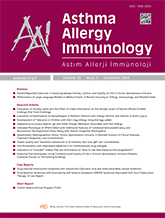


Objective: Allergic diseases have rapidly increased over the last decades. Allergic sensitization is a key step in developing allergic diseases, and sensitization to airborne allergens is consistently the strongest identified risk factor for asthma and allergic rhinitis (AR). Our study aims to elucidate the prevalence of various allergens leading to AR and asthma through skin prick tests (SPTs) in North Cyprus.
Materials and Methods: This retrospective study was conducted between April 2023 and March 2024 at our Hospital`s Pediatric Immunology and Allergy outpatient clinic, involving pediatric patients diagnosed with AR and asthma, and aged under 18 years. SPT was performed to detect aeroallergen sensitization.
Results: A total of 261 patients were included in this study, with 55.20% (n=144) being male. The median age of the patients was 85 months (IQR:57.5-116). Allergic rhinitis, wheezy child, and asthma were diagnosed in 70.10% (n=183), 26.80% (n=70), and 35.20% (n=92) of the patients, respectively. Out of the 261 patients, 62.10% (n=162) had SPT positivity. The most frequent allergen was house dust mite (HDM) at 41% (n=107). The second most frequent allergen was tree pollen (26.40%, n=69), followed by grass allergen (24.50%, n=64). Patients under 6 years of age showed higher SPT negativity with aeroallergens, while patients above 6 years of age showed higher SPT positivity with aeroallergens (p=0.020). Patients having both asthma and allergic rhinitis showed higher SPT positivity with aeroallergens (p=0.035). The percentage of patients who were positive with Ambrosia artemisifolia, Artemisia vulgaris, and Fraxinus excelsior allergens was higher in patients diagnosed with asthma, and both asthma and allergic rhinitis (p=0.027, 0.001, and 0.042, respectively). Patients who had mold, Alternaria alternate, and Secale cereale allergen positivity were more common in non-controlled asthma (p=0.029, 0.049, and 0.028, respectively). Patients having dog and grass allergens positivity were more common in persistent AR (p=0.044, and 0.036 respectively).
Conclusion: In conclusion, patients diagnosed with asthma and/or allergic rhinitis in North Cyprus most frequently showed allergen sensitization to house dust mites, followed by pollens.